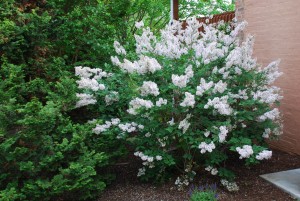When northerners move south, they insist on growing lilacs (Syringa spp.). Southern U.S. heat and humidity often take their toll on these lovely fragrant and colorful spring flowering shrubs (USDA hardiness zones 3-8).
One very popular and exceptionally reliable lilac is ‘Miss Kim’ lilac (S. pubescens ssp. patula ‘Miss Kim’). A cultivar of Manchurian lilac, it develops into a compact, upright branched, 5 to 7 foot deciduous shrub. The sweetly fragrant lavender (in bud), ice blue single flowers form in dense panicles or clusters. Flower panicles average 3 inches in length and cover the shrub in early May.
Prompt removal of faded flower panicles before seed set will increase bloom count next spring.
The rounded (ovate) 4-5 inch dark green leaves develop a burgundy look before dropping in the autumn. Miss Kim does not sucker like some lilac cultivars. It has no serious insect or disease problems. Miss Kim lilac exhibits high resistance to powdery mildew. Deer don’t seem to bother lilacs unless favorite food sources are depleted. Lilac blooms attract numerous hummingbirds and butterflies.
Lilacs are not fussy growers, and thrive in average, mildly acidic to neutral pH, well-drained soils. They tolerate light shade, but flowering and overall performance are best in full sun. Avoid overcrowding for good air circulation to prevent or reduce mildew disease.
‘Miss Kim has been the top performing lilac in the Southern Appalachian region (USDA hardiness zones 6 and 7). Cutflowers decorate dining table when Miss Kim is in bloom.


 Posted in
Posted in 
